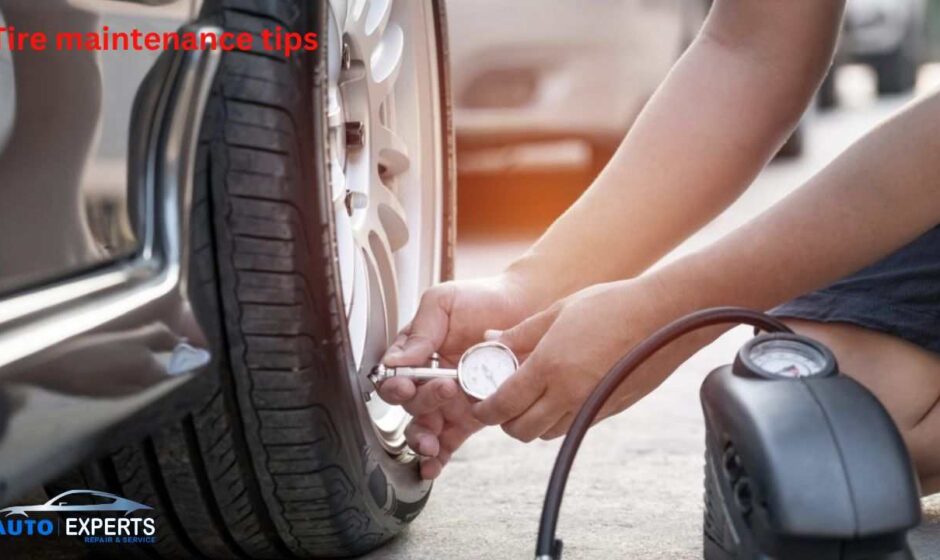Tire maintenance is crucial for safe and efficient driving. Properly maintained tires improve vehicle performance, enhance fuel efficiency, and ensure safety on the road. This article provides essential tire maintenance tips to help you keep your tires in top condition.
Top Tire Maintenance Tips
1. Regularly Check Tire Pressure
Maintaining the correct tire pressure is vital for tire longevity and vehicle safety. Underinflated tires can cause poor fuel efficiency and uneven wear, while overinflated tires can lead to a harsh ride and increased risk of blowouts. Check your tire pressure at least once a month and before long trips. Use a reliable tire pressure gauge and compare the readings with the manufacturer’s recommended pressure, usually found in the owner’s manual or on a sticker inside the driver’s door.
2. Inspect Tires for Wear and Damage
Regularly inspect your tires for signs of wear and damage. Look for uneven tread wear, cracks, cuts, or punctures. Uneven tread wear can indicate alignment or suspension issues, while visible damage may require immediate repair or replacement. Use the penny test to check tread depth: insert a penny into the tire tread with Lincoln’s head upside down. If you can see the top of Lincoln’s head, it’s time to replace the tire.
3. Rotate Tires Regularly
Tire rotation is essential for even tire wear and extended tire life. Rotate your tires every 5,000 to 8,000 miles, or as recommended by your vehicle’s manufacturer. Regular rotation helps distribute wear evenly across all tires, promoting a smoother ride and improving tire performance. Follow the recommended rotation pattern for your vehicle, usually found in the owner’s manual.
4. Balance and Align Tires
Proper tire balancing and alignment are crucial for optimal tire performance and longevity. Unbalanced tires can cause vibrations, uneven wear, and stress on the suspension system. Have your tires balanced whenever you install new tires or notice vibrations while driving. Alignment ensures that your vehicle’s wheels are set to the correct angles, preventing uneven tire wear and improving handling. Get your alignment checked if you notice uneven tire wear, steering issues, or after hitting a curb or pothole.
5. Avoid Overloading Your Vehicle
Overloading your vehicle puts excessive stress on your tires, leading to increased wear and potential tire failure. Always adhere to the recommended load capacity specified by your vehicle’s manufacturer. Overloading can cause tires to overheat, increasing the risk of blowouts and reducing overall tire life. Distribute the load evenly and avoid carrying unnecessary weight to prolong tire life and ensure safety.
6. Drive Carefully
Your driving habits significantly impact tire wear and performance. Avoid aggressive driving, such as rapid acceleration, hard braking, and sharp turns, as these actions can cause premature tire wear and damage. Drive smoothly and maintain a safe speed to reduce stress on your tires and enhance fuel efficiency. Avoid potholes, debris, and rough road surfaces whenever possible to prevent tire damage.
7. Keep Tires Clean
Keeping your tires clean not only improves their appearance but also helps prevent damage. Clean your tires regularly using mild soap and water to remove dirt, grime, and road salt. Avoid using harsh chemicals or abrasive brushes that can damage the tire’s surface. Clean tires are less likely to develop cracks and other issues that can compromise their performance and safety.
8. Store Tires Properly
If you need to store your tires, such as when switching between summer and winter tires, proper storage is essential to maintain their condition. Store tires in a cool, dry place away from direct sunlight and heat sources. Keep them upright or stack them horizontally, but never hang them, as this can cause deformation. Use tire covers or plastic bags to protect them from dust and moisture.
9. Replace Tires When Necessary
Knowing when to replace your tires is crucial for your safety. Most tires have tread wear indicators, which are small raised bars located within the grooves of the tread. When the tread wears down to the level of these indicators, it’s time to replace the tire. Additionally, if you notice any signs of damage, such as bulges, blisters, or severe cracks, replace the tire immediately. Driving on worn or damaged tires increases the risk of accidents and can compromise your vehicle’s performance.
Conclusion
Regular tire maintenance is essential for safe, efficient, and enjoyable driving. By following these tire maintenance tips, you can extend the life of your tires, improve your vehicle’s performance, and ensure your safety on the road. Check tire pressure regularly, inspect for wear and damage, rotate and balance your tires, and drive carefully to keep your tires in top condition. Proper tire care not only saves you money in the long run but also enhances your driving experience.



